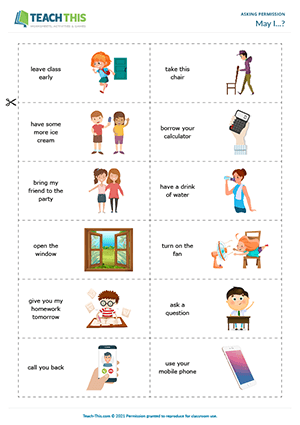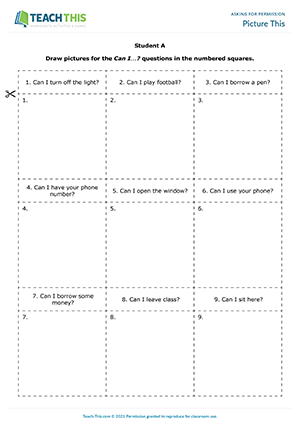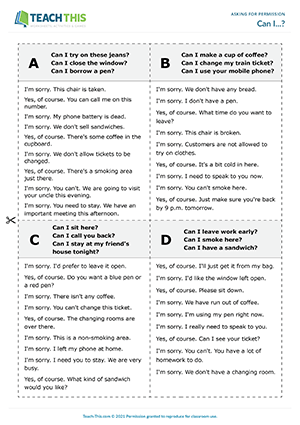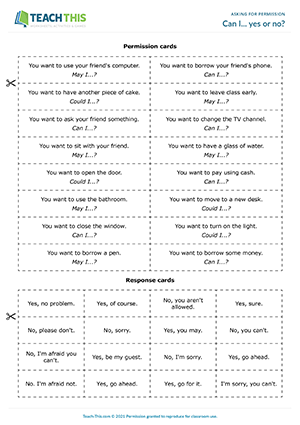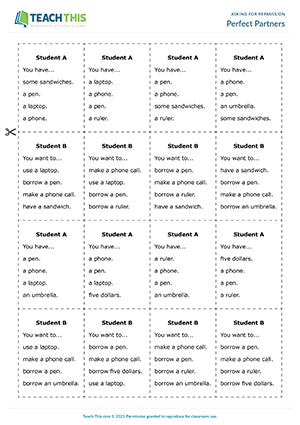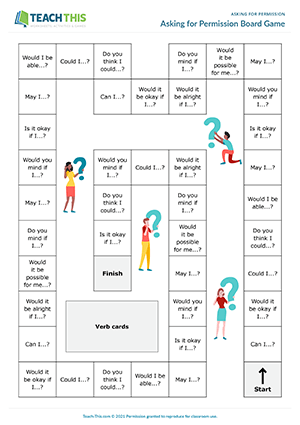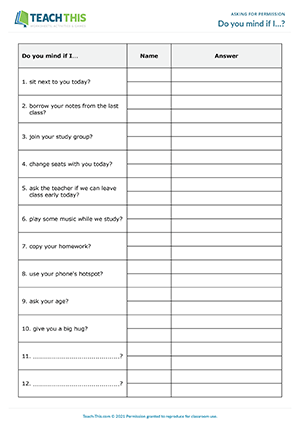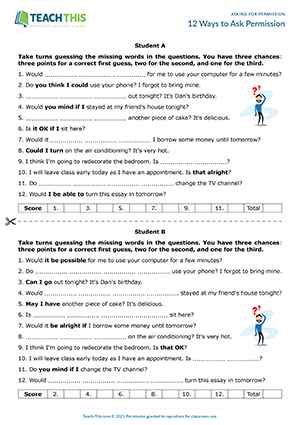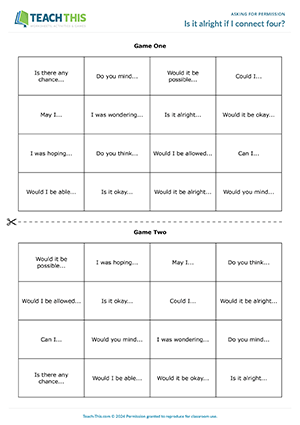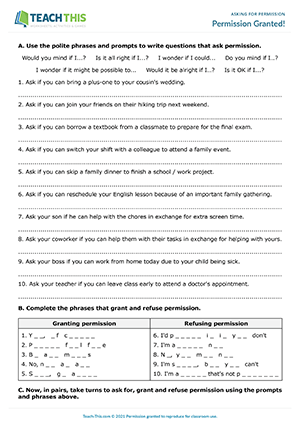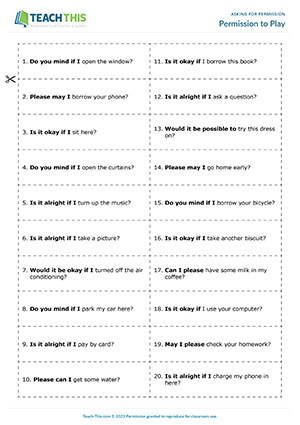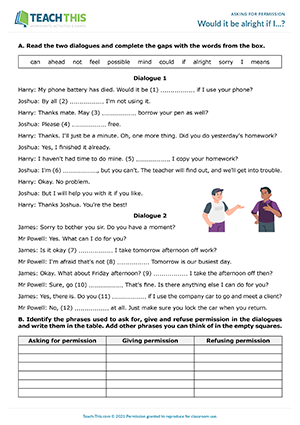In this free asking for permission speaking activity, students practice asking for, giving and refusing permission using cards as prompts. On one side of the card is a permission prompt and on the other is a tick or cross. Students hold their cards so the permission prompt is facing towards them and the tick or cross is facing away. Students then go around the class asking for, giving and refusing permission with as many partners as possible. If students see a tick, they give permission. If there is a cross, students refuse permission. When the students have finished, they repeat the activity, but this time they hold their card the other way around so the permission prompt is facing away. Students then go around the class, asking for permission to do different things each time they speak to a classmate.
In this creative asking for permission game, students draw pictures of situations where people ask for permission and a partner tries to guess the Can I...? question for each one. First, in two groups, students draw pictures that illustrate Can I...? questions in numbered squares. For example, if the question was 'Can I borrow a pencil?', the student might draw a picture of someone with a piece of paper and nothing in their hand. Students then cut the worksheet so the drawings and questions are separate. Next, students pair up with someone from the other group and give their partner the drawings. Students then take turns guessing the Can I...? question for each of their partner's pictures. Students have three chances to guess the question for each picture. If a student guesses correctly the first time, they score three points. On the second try, they get two points. On the third try, they score one point. The student with the most points at the end of the game wins.
In this engaging asking for permission game, students ask permission to do different things using Can I...? and race to find the person who gives permission. Each card contains three Can I...? questions that ask for permission and nine replies that give or refuse permission. In groups, students take turns asking a Can I...? question on their card to one of the other group members, e.g. 'Can I try on these jeans?' The chosen student then looks for a matching reply on their card. If the student gives permission by saying 'Yes, of course...', the other student crosses off the question. If the student refuses permission by saying 'I'm sorry...', the other student waits until their next turn before asking permission from another person. The first student to cross off all their Can I...? questions wins the game.
In this fun modal verbs of permission game, students ask for permission to do various things and guess whether their partner is going to grant or refuse permission. This game helps students practice the modals of permission can, may and could as well as various phrases for granting and refusing permission. In pairs, students take turns picking up a permission card and using the modal verb of permission and prompt shown on the card to ask for permission to do something, e.g. 'May I use your computer?' The student then guesses whether their partner will grant or refuse permission. Their partner then picks up a response card and grants or refuses permission using the expression on the card, e.g. 'Yes, no problem.' If the student guessed correctly, they score a point. If not, their partner scores a point. The student with the most points at the end of the game wins.
In this communicative asking for permission activity, students practice asking for, giving and refusing permission. Students imagine that they are going to try to find their perfect partner by asking, giving and refusing permission for the things on their card. If they find someone who asks or gives permission for all four items on their card, they have found their perfect partner. The students with card A sit down. Their task is to give or refuse permission. If a student asks permission for an item on their card, they give it. If a student asks permission for something that isn't on their card, they refuse permission and give a reason. The students with card B go around asking the students sitting down permission for the things shown on their card, e.g. 'Can I borrow a pen?' If a student gets permission for all four things on their card, they have found their perfect partner and sit down with them. If a student is refused permission for anything on their card, they move on and speak to another student. When everyone has found their partner, students swap roles to give them practice using all the language.
This free asking for permission board game helps students practice asking for, granting and refusing permission using a variety of phrases. In groups, players take turns rolling the dice and moving their counter along the board. When a player lands on a square, they pick up a card and ask for permission using the verb on the card and the phrase on the square. For example, if the player lands on the Do you think I could...? square and picks up the 'have' verb card, the student might say 'Do you think I could have another cup of coffee?' The other students in the group judge whether the question has been phrased correctly and is appropriate. If it is, the students grant permission, e.g. 'Go right ahead.' If not, the students refuse permission (e.g. I'm afraid that's not possible.), and the player goes back two squares. The first player to reach the finish wins the game.
Here is a communicative asking for permission activity to help students practice asking for permission with Do you mind if I...? and responding by either granting or refusing permission. Students go around the class asking permission for the things shown on their worksheet using Do you mind if I...? Students only give permission if they genuinely think they don't mind. If students do mind, they refuse permission and explain why. When a classmate gives or refuses permission, the student writes down their name and answer on the worksheet. This continues until each student has two responses for each item. Afterwards, students give feedback to the class on the people who gave and refused permission.
In this enjoyable asking for permission game, students practice 12 ways to ask permission by guessing missing words in questions. In pairs, one student begins by guessing the missing words in the first question that asks for permission. Their partner listens and tells them if they are correct or not. If the student guesses correctly the first time, they score three points and write the words in the gaps. On the second try, they get two points. On the third try, they score one point. After the missing words have been guessed correctly or three chances have passed, their partner guesses the missing words in the second question, and so on. The student with the most points at the end of the game is the winner.
In this useful asking for permission game, students play Connect Four by using common phrases to form questions that ask for permission. To begin, the first player chooses a square. The other player then picks up a situation card and reads it aloud. The first player then uses the phrase from the square to form a relevant question based on the situation that asks for permission. For example, for the square Is there any chance... and the situation 'You have been invited to a party and would like to bring a guest', the player could say 'Is there any chance I could bring a guest to the party?' If the other player agrees that the question is correct and appropriate, the player marks the square with an 'X' or an 'O', and the situation card is set aside. If not, the player doesn't mark the square, and the situation card is placed at the bottom of the pile. It is then the other player's turn to choose a square. The first player to get four squares in a row wins the game. Afterwards, pairs play a second game using the remaining situation cards.
Here is a productive asking for permission worksheet to help students practice language for asking, granting and refusing permission. First, students use polite phrases and prompts to write questions that ask for permission. Students then complete phrases that grant and refuse permission. Finally, in pairs, students take turns to ask for, grant and refuse permission using the prompts and polite phrases.
Here are two entertaining asking for permission games to help students practice a variety of common phrases that ask for permission. In pairs, students begin by playing a miming game where they mime questions that ask permission for a partner to guess. Students take turns picking up a question card and saying the asking for permission phrase written in bold, e.g. Do you mind if I... The student then mimes the rest of the question to their partner, who has 30 seconds to guess what it is. If the student guesses correctly (e.g. Do you mind if I open the window?), they win and keep the card. If not, their partner keeps the card. The student with the most cards at the end wins. Next, students play a game where they match each question that asks for permission with a suitable response. Students take turns turning over a question card and a response card. If the response matches the question, the student keeps the two cards and has another turn. If not, the student turns both cards back over and play passes to the other student. The student with the most cards at the end of the game wins.
In this comprehensive asking for permission worksheet, students practice phrases for asking, giving and refusing permission. First, students read two dialogues and complete them with words from a box. Students then identify the phrases used to ask for, give and refuse permission in the two dialogues and write them in a table, adding other phrases they can think of in the empty squares. Next, students write questions that ask for permission using the phrases from the table and write a response to each question, giving or refusing permission. After that, students rewrite short dialogues that ask for permission to make them more polite. Finally, students write questions that ask for permission and then practice asking for, giving and refusing permission with a partner.
Latest Free
Resources
- The Bus Stop
Getting Around (B1)
Date Added: 1st of October
- Study Skills Showdown
Study Skills (B2)
Date Added: 10th of September
- Everyday Objects Bingo
Everyday Objects (A1-A2)
Date Added: 25th of August
- Action Verb Races
Actions (A1-A2)
Date Added: 18th of August
- Birthday Basics
Birthdays (A1-A2)
Date Added: 8th of August
Latest Member
Resources
- Casual Greetings
Greetings and Introductions (B2)
Date Added: 22nd of October
- Identifying and Clarifying Problems
Dealing with Problems (B2)
Date Added: 22nd of October
- What if we tried...?
Dealing with Problems (B2)
Date Added: 22nd of October
- Suitable Excuses
Making Excuses (B2)
Date Added: 21st of October
- Superlatives Showdown
Superlatives (A1-A2)
Date Added: 21st of October



